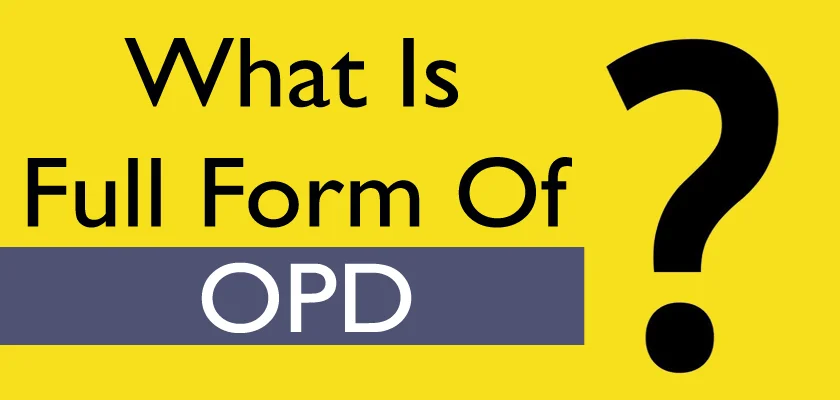Do you know what is the OPD Full Form in Medical? The full form of OPD in medical is Outpatient Department. In modern healthcare facilities, one of the most important departments is the Outpatient Department (OPD). OPD is a crucial part of healthcare services that deals with the diagnosis and non-emergency treatment of patients who require medical attention but do not require hospitalization.
Table of Contents
The OPD is staffed with experienced and knowledgeable medical professionals to provide patients with the highest quality of care. In this article, we will delve into the full form of OPD in medical, the role of OPD in medical facilities, the different types of OPDs, the importance of OPD in patient care, operational procedures in an OPD, the benefits of OPD for patients and healthcare providers, how to schedule an appointment in the OPD and the significance of OPD in modern healthcare.
Introduction to OPD Full Form in Medical
What is the OPD Full Form in Medical?
OPD Full Form in Medical- Outpatient Department
What is OPD?
OPD stands for Out Patient Department. It is a medical facility within a hospital or a clinic where patients can receive medical consultation, diagnosis, and treatment without being admitted to the hospital.
Explanation of OPD Full Form in Medical
The OPD full form in Medical is Out Patient Department. This department is designed to provide outpatient medical services to patients who do not require overnight hospitalization.
Understanding the Role of OPD in Medical Facilities
Primary Function of OPD in Medical Centers
The primary function of the OPD in a medical centre is to provide medical consultation, diagnostic services, and treatment to patients who are not required to be hospitalized. This is done through the examination and evaluation of the patient’s medical history, symptoms and laboratory tests.
Significance of OPD in Patient Care and Treatment
The OPD plays a critical role in patient care and treatment as it provides an avenue for patients to seek medical attention promptly. This helps in determining the severity of the medical condition and preventing it from getting worse. It also helps to reduce the burden of inpatient care and reduce healthcare costs.
Different Types of OPDs in Medical Centers
General OPD
General OPD is a department of a medical centre that provides services to patients who do not require specialized treatment. These conditions may include fever, cough, cold, abdominal pain and other minor ailments.
Speciality OPD
Speciality OPD is a department of a medical centre that provides specialized treatment for patients with specific medical conditions. The department works with specialists specializing in specific areas such as cardiology, neurology, dermatology and gastroenterology.
Emergency OPD
Emergency OPD is a division of a medical centre that provides urgent care to patients with critical medical issues that demand prompt medical attention. This includes accidents, heart attacks, stroke and other serious diseases.
Importance of OPD in Patient Care and Treatment
Role of OPD in Diagnosis and Treatment Planning
OPD is important in the diagnosis and planning of patient care. OPD assistance involves medical consultation and examination by the doctor to assess the severity of the patient’s illness and choose the best course of action.
How OPD Helps to Manage and Monitor Patient’s Health
The OPD assists in the management and administration of patient health by providing follow-up consultations and monitoring patient progress. This helps to ensure that the patient is making progress towards recovery and that any further treatment is provided if necessary.
Operational Procedures in an OPD
When patients visit an OPD, they go through a well-defined workflow that includes several stages such as registration, consultation, examination, diagnosis, and treatment. The operational procedures in an OPD aim to provide efficient and effective care, while also ensuring patient safety and satisfaction.
Overview of OPD Workflow
The OPD workflow typically begins with the patient’s registration, which involves creating a personalized medical record and collecting relevant details such as medical history, allergies, and current medications. The patient is then directed to the waiting area until their turn for consultation with the physician. During the consultation, the physician assesses the patient’s symptoms and medical history, performs relevant examinations, and orders any necessary diagnostic tests. Once the diagnosis is confirmed, the patient receives treatment or is referred to a specialist for further care.
Roles and Responsibilities of OPD Staff
An OPD comprises a team of healthcare professionals, including physicians, nurses, technicians, and support staff. Each member plays a crucial role in ensuring the smooth functioning of the OPD. Physicians are responsible for conducting consultations, making diagnoses, and prescribing treatments. Nurses assist with patient care, manage patient records, and provide counselling. Technicians handle diagnostic tests, such as blood tests or X-rays, and ensure that the medical equipment is functioning correctly. Support staff, including receptionists and administrative personnel, assist with appointment scheduling, patient management, and medical record upkeep.
Common Medical Equipments in OPD
The OPDs have a range of medical tools and equipment to help with consultations, diagnoses, and treatments. OPDs frequently have stethoscopes, blood pressure monitors, thermometers, otoscopes, ophthalmoscopes, ECG machines, X-ray machines, ultrasound machines, nebulizers, and other diagnostic medical equipment.
Benefits of OPD for Patients and Healthcare Providers
OPDs offer several benefits for both patients and healthcare providers.
Advantages of OPD for Patients
OPD has drastically decreased patient wait times for medical attention, improving accessibility and effectiveness for all patients. Also, OPDs provide a serene and stress-free setting that makes it easier for patients to get medical attention. A variety of clinicians, including specialists, who might not be accessible in other healthcare institutions are also made available in this setting.
Benefits of OPD for Healthcare Providers
OPD enables medical personnel to organise and systematically manage a large number of patients. Also, it helps doctors diagnose and treat patients more quickly, which may ultimately result in better outcomes. The most recent medical innovations enable healthcare professionals to deliver more efficient care, which raises patient satisfaction.
How to Schedule an Appointment in the OPD
Booking an appointment in the OPD is usually straightforward and can be done in several ways.
Ways to Book an OPD Appointment
Patients can book an appointment by calling the OPD directly, visiting the OPD to make a personal appointment or utilizing the online appointment booking system. Basic information like a patient’s name, contact information, and preferred appointment date and time is frequently requested for booking an OPD appointment.
What to Expect During an OPD Visit
Patients should bring their medical documents and information about their current health state to the OPD appointment. Normally, a registration process would be followed by a doctor’s consultation for patients. Patients should perform all required diagnostic procedures, get a diagnosis, and get the right kind of care.
Conclusion
OPDs give people quick access to effective healthcare that can handle huge patient volumes while maintaining high standards of service. They are an essential component of contemporary healthcare and will remain so as the industry develops.

FAQs – What is the OPD Full Form in Medical?
What is the OPD Full Form in Medical?
The OPD Full Form is an “Out-Patient Department”.
What is an OPD?
An OPD is a section or department of a hospital or healthcare facility where patients receive medical care without being admitted as inpatients.
What services are provided in an OPD?
OPDs offer a wide range of medical services, including consultation with doctors, diagnostic tests, minor procedures, and follow-up care.
Is an appointment required for an OPD visit?
In most cases, appointments are required for an OPD visit. However, emergency cases may be seen without an appointment.
What are the benefits of visiting an OPD?
The benefits of visiting an OPD include faster medical attention, access to specialists, cost-effectiveness, and reduced hospital stay.
What Is OPD Full Form in Medical Insurance
The full form of OPD is the Outpatient Department.
Thanks for reading What is the OPD Full Form in Medical? Bookmark our website Whatisfullform.com to know or read our collection of full forms.


